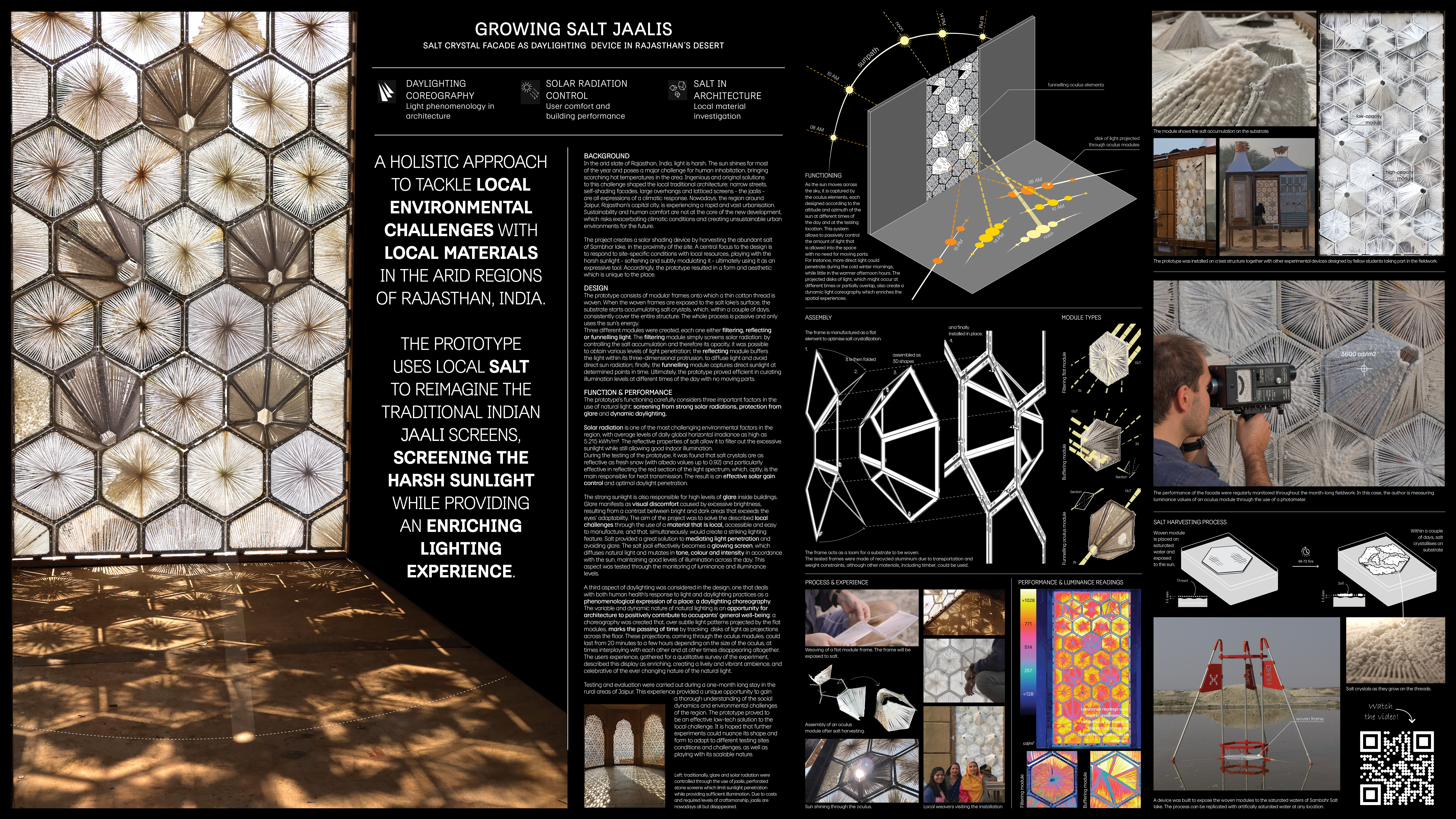2024 - Growing Salt Jaalis

Category
Daylight Investigations - Region 1: Western Europe
Students
Giacomo Brusa Cattaneo
Teacher
David Garcia
School
Royal Danish Academy
Country
Denmark
Download
Download project board
In the arid state of Rajasthan, India, light is harsh. The sun shines for most of the year and poses a major challenge for human inhabitation, bringing scorching hot temperatures in the area. Ingenious and original solutions to this challenge shaped the local traditional architecture: narrow streets, self-shading facades, large overhangs and latticed screens – the jaalis – are all expressions of a climatic response. Nowadays, the region around Jaipur, Rajasthan’s capital city, is experiencing a rapid and vast urbanisation. Sustainability and human comfort are not at the core of the new development, which risks exacerbating climatic conditions and creating unsustainable urban environments for the future. The project creates a solar shading device by harvesting the abundant salt of Sambhar lake, in the proximity of the site. A central focus to the design is to respond to site-specific conditions with local resources, playing with the harsh sunlight – softening and subtly modulating it – ultimately using it as an expressive tool. Accordingly, the prototype resulted in a form and aesthetic which is unique to the place.
DESIGN
The prototype consists of modular frames onto which a thin cotton thread is woven. When the woven frames are exposed to the salt lake’s surface, the substrate starts accumulating salt crystals, which, within a couple of days, consistently cover the entire structure. The whole process is passive and only uses the sun’s energy. Three different modules were created, each one either filtering, reflecting or funnelling light. The filtering module simply screens solar radiation: by controlling the salt accumulation and therefore its opacity, it was possible to obtain various levels of light penetration; the reflecting module buffers the light within its three-dimensional protrusion, to diffuse light and avoid direct sun radiation; finally, the funnelling module captures direct sunlight at determined points in time. Ultimately, the prototype proved efficient in curating illumination levels at different times of the day with no moving parts.
FUNCTION & PERFORMANCE
The prototype’s functioning carefully considers three important factors in the use of natural light: screening from strong solar radiations, protection from glare and dynamic daylighting. Solar radiation is one of the most challenging environmental factors in the region, with average levels of daily global horizontal irradiance as high as 5.215 kWh/m². The reflective properties of salt allow it to filter out the excessive sunlight while still allowing good indoor illumination. During the testing of the prototype, it was found that salt crystals are as reflective as fresh snow (with albedo values up to 0.92) and particularly effective in reflecting the red section of the light spectrum, which, aptly, is the main responsible for heat transmission. The result is an effective solar gain control and optimal daylight penetration. The strong sunlight is also responsible for high levels of glare inside buildings. Glare manifests as visual discomfort caused by excessive brightness, resulting from a contrast between bright and dark areas that exceeds the eyes’ adaptability. The aim of the project was to solve the described local challenges through the use of a material that is local, accessible and easy to manufacture, and that, simultaneously, would create a striking lighting feature. Salt provided a great solution to mediating light penetration and avoiding glare. The salt jaali effectively becomes a glowing screen, which diffuses natural light and mutates in tone, colour and intensity in accordance with the sun, maintaining good levels of illumination across the day. This aspect was tested through the monitoring of luminance and illuminance levels.
A third aspect of daylighting was considered in the design, one that deals with both human health’s response to light and daylighting practices as a phenomenological expression of a place: a daylighting choreography. The variable and dynamic nature of natural lighting is an opportunity for architecture to positively contribute to occupants’ general well-being: a choreography was created that, over subtle light patterns projected by the flat modules, marks the passing of time by tracking disks of light as projections across the floor. These projections, coming through the oculus modules, could last from 20 minutes to a few hours depending on the size of the oculus, at times interplaying with each other and at other times disappearing altogether. The users experience, gathered for a qualitative survey of the experiment, described this display as enriching, creating a lively and vibrant ambience, and celebrative of the ever changing nature of the natural light. Testing and evaluation were carried out during a one-month long stay in the rural areas of Jaipur. This experience provided a unique opportunity to gain a thorough understanding of the social dynamics and environmental challenges of the region. The prototype proved to be an effective low-tech solution to the local challenge. It is hoped that further experiments could nuance its shape and form to adapt to different testing sites conditions and challenges, as well as playing with its scalable nature.

























